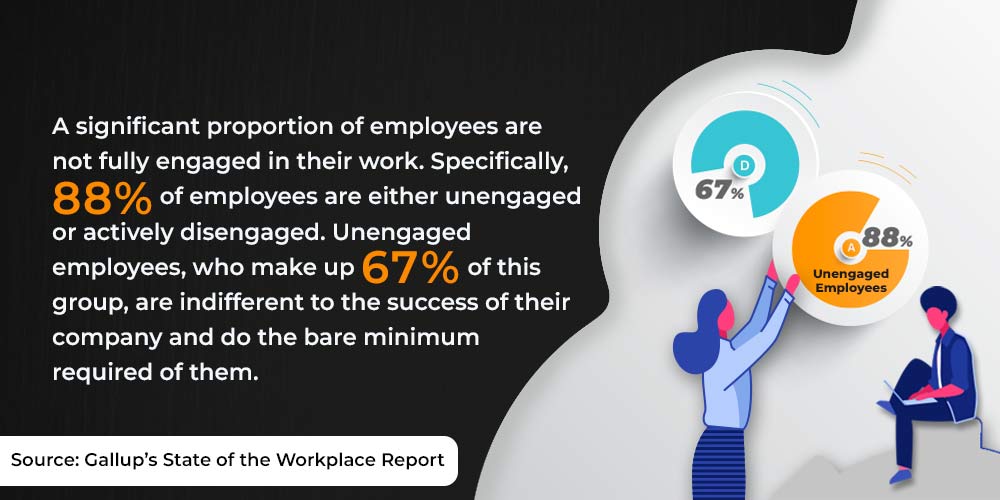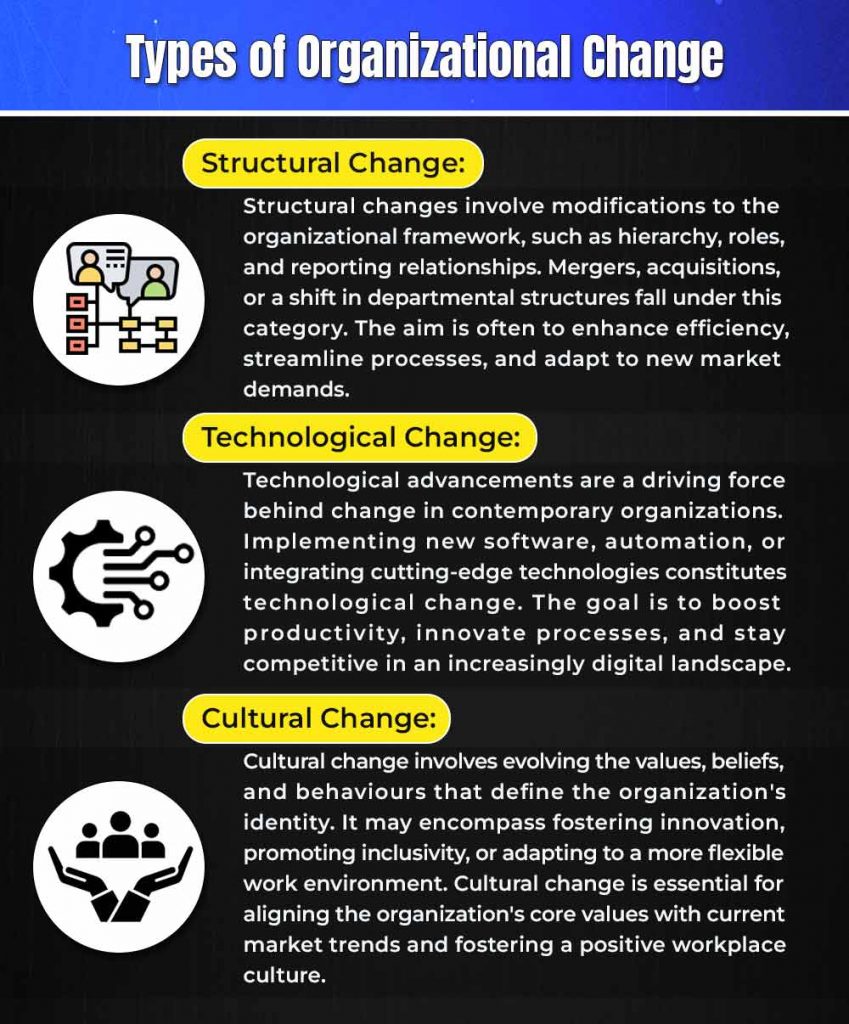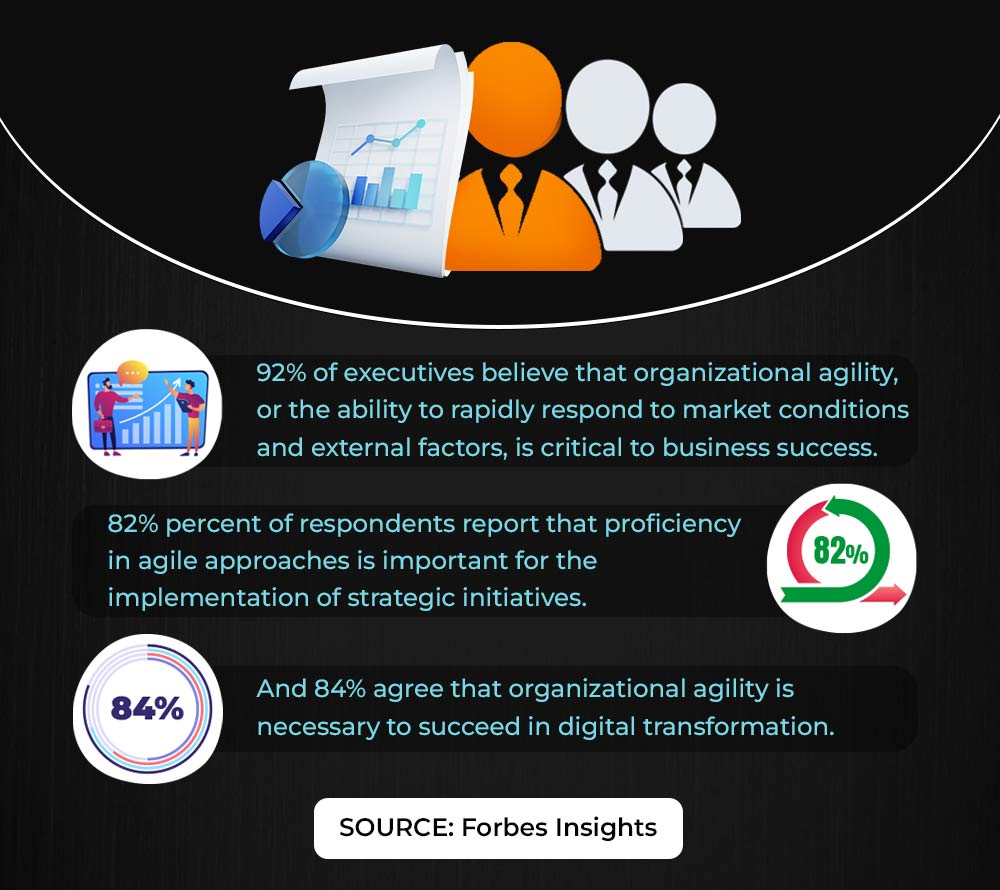How Organizational Change Impacts Work Culture
Organizational change refers to the intentional modification of an organization’s structure, processes, or culture to enhance its overall effectiveness and adaptability. These changes can stem from internal initiatives, external pressures, technological advancements, or shifts in market demands. As organizations strive to stay ahead in a constantly evolving landscape, the ability to embrace and manage change becomes a critical factor for sustained success.
Impact on Work Culture
Work culture, the collective values, beliefs, and behaviors within an organization, plays a pivotal role in how employees perceive and respond to change. Recognizing the symbiotic relationship between organizational change and work culture is essential. A positive work culture not only fosters resilience during transitions but also contributes to the overall success of change initiatives. Conversely, a misalignment between change and culture can lead to resistance, decreased morale, and hindered productivity.


Organizational change and work culture share a profound and interconnected relationship, shaping the success or failure of transitions. This symbiosis is evident in how the dynamics of one influence and, in turn, are influenced by the other.


When there is coherence between the desired change and the prevailing culture, employees are more likely to embrace and adapt to the new direction. A positive work culture acts as a catalyst, influencing how employees perceive and respond to change.


Real-world examples of organizations that successfully navigated change through cultural alignment.
- Salesforce: Building Community and Equality
Salesforce, a global cloud software leader, owes its stellar workplace reputation to a deeply ingrained culture centered around trust, customer success, innovation, and equality. The commitment to equality is tangible through efforts to eliminate the wage gap and unbiased hiring. Salesforce’s 1-1-1 model, emphasizing community giveback, further cements its cultural alignment, fostering team unity and devotion.
- HubSpot: Dynamic Values and Employee Empowerment
HubSpot sees its culture as a dynamic entity, as outlined in its Culture Code highlighting values like humility, empathy, adaptability, remarkability, and transparency (HEART). Investing significantly in employee development, HubSpot offers tools and programs, balancing hard work with employee well-being through unlimited PTO and paid sabbaticals.
- Spotify: Simplifying Structures for Autonomy
Spotify disrupts the norm with a unique organizational model using “squads,” “tribes,” and “guilds” for streamlined accountability and autonomy. Simplicity and self-management facilitate fast product development, creating a workplace where employees enjoy innovation and connectivity.
- LinkedIn: Prioritizing People and Inclusivity
LinkedIn’s people-first culture, encapsulated in “#LinkedInLife,” emphasizes a shared sense of belonging, flexibility, ambitious dreams, and inclusivity. Consistently recognized as a Best Place to Work, LinkedIn’s culture contributes to a caring workforce, genuine leadership, and a challenging yet rewarding environment.
- Zappos: Customer-Centric Transformation through Holacracy
Zappos, the online retail giant, undergoes a customer-centric transformation by adopting a holacracy model, aligning its culture with individual autonomy and innovation. Investing in employee training and development, Zappos stands as proof that prioritizing customer service, company culture, and employee growth yields lasting benefits.
Communicating Change Effectively
Effective communication is the linchpin of successful organizational change. Transparent and empathetic communication fosters understanding, allays concerns, and instills confidence in employees. In this section, we explore tips for leaders to navigate this crucial aspect of change management.
A newer study from the McKinsey Institute about the future of remote work suggests that employees who feel included in more detailed workplace communication are almost 5 times more likely to report increased productivity.
Tips for Transparent and Empathetic Communication:
1. Early and Honest Communication:
Commence communication about change as early as possible. Be transparent about the reasons behind the change and the expected impact. Honest communication builds trust and helps employees comprehend the necessity of the change.
2. Open Channels for Feedback:
Encourage an open dialogue by providing channels for employees to share their thoughts, questions, and concerns. This not only helps leaders address specific worries but also makes employees feel heard and valued.
Research by Towers Watson revealed that organizations with effective communication during change had 47% higher total returns to shareholders over five years.
3. Consistent Updates:
Maintain a regular cadence of communication to keep employees informed about the progress of the change. Consistent updates, whether through town hall meetings, newsletters, or virtual platforms, create a sense of stability and reduce uncertainty.
A Gallup poll found that organizations with highly engaged employees experienced 21% higher profitability.
4. Use Empathetic Language:
Communicate with empathy, acknowledging the impact of the change on employees. Use language that resonates with their experiences and emotions. This humanizes the communication process, making it more relatable.
Managing Resistance to Change
Organizational change often encounters resistance, which can manifest in various forms. Identifying common sources of resistance and employing effective strategies is pivotal for successful change management.
1. Fear of the Unknown:
Change introduces uncertainty, triggering a fear of the unknown among employees. The lack of clarity about the future and how it will impact individuals can lead to resistance.
2. Loss of Control:
Employees may resist change when they feel a loss of control over their roles or daily activities. A perceived threat to autonomy can evoke resistance.
3. Lack of Communication:
Inadequate or unclear communication about the reasons for change and its potential impact can create a gap in understanding, fostering resistance.
4. Past Negative Experiences:
Previous experiences with unsuccessful changes can make employees skeptical, contributing to a reluctance to embrace new initiatives.
Strategies for Addressing Resistance:
1. Communication and Transparency:
Regular and transparent communication about the reasons for change, expected benefits, and potential challenges can mitigate uncertainty and address resistance stemming from a lack of information.
2. Involvement and Participation:
Including employees in the decision-making process and seeking their input can empower them, reducing resistance by making them feel valued and involved.
3. Providing Training and Support:
Offering training programs and ongoing support can address resistance arising from a perceived lack of skills or knowledge needed to adapt to the change.
4. Recognizing and Celebrating Small Wins:
Acknowledging and celebrating incremental successes throughout the change process reinforces positive behaviors and fosters a sense of accomplishment, reducing resistance.
Leadership’s Pivotal Role in Organizational Change
Leadership plays a central and irreplaceable role in steering organizations through change. Adept leaders not only navigate transitions effectively but also inspire and guide their teams toward successful adaptation. Leadership’s effectiveness during transitions hinges on proactive measures that minimize disruptions and facilitate a smoother change process.
Proactive Leadership Measures to Minimize Disruptions:
1. Comprehensive Planning:
Leaders should invest time in comprehensive planning before initiating change. Anticipating potential challenges and crafting a well-thought-out strategy minimizes disruptions during implementation.
2. Clear Communication Channels:
Establishing clear communication channels is vital. Leaders should ensure that information flows seamlessly across all levels, keeping everyone informed and reducing uncertainty.
3. Employee Training and Support:
Proactive leaders invest in employee training and support programs. Preparing the workforce for the upcoming changes equips them with the skills and knowledge necessary to navigate transitions with minimal disruptions.
4. Establishing Change Champions:
Identifying and empowering change champions within the organization fosters a culture of support and guidance. These individuals can assist their peers in adapting to new processes and minimizing disruptions through peer-to-peer mentorship.
5. Regular Progress Assessments:
Leaders should conduct regular assessments to gauge progress and identify potential roadblocks. This proactive approach allows for timely adjustments, ensuring that the change initiative stays on course.
Effects of Leadership on Change Management
In the realm of organizational dynamics, the enduring impact of effective leadership in change management is profound and far-reaching. Beyond the immediate throes of transition, such leadership paves the way for a future characterized by sustained success.
Organizational Agility
A key facet of this enduring impact is the cultivation of improved organizational agility. Through adept guidance, leaders instill a capacity for quick adaptation, positioning the company favorably in the face of ever-evolving business landscapes.


Employee Engagement
Furthermore, the ripple effects extend to the realm of employee engagement. Leadership that deftly manages change creates a culture marked by trust and transparency. This not only enhances immediate job satisfaction but also nurtures a workforce that remains engaged and loyal in the long term.
Innovation & Creativity
The legacy of effective change leadership also manifests in increased innovation and creativity within the organizational fabric. By fostering a culture that encourages idea contribution and calculated risk-taking, leaders set the stage for continuous improvement and long-term success.
Employer Branding
Perhaps equally impactful is the positive employer branding that results from successful change navigation. Organizations with a reputation for adept change management practices become magnets for top talent.
This positive perception, carefully crafted by effective leadership, contributes significantly to the organization’s enduring success. In essence, the long-term effects of effective leadership in change management create a trajectory where adaptability, engagement, innovation, and positive reputation converge to define a future marked by sustained triumphs.
As we navigate the complexities of transition, the long-term effects of adept guidance become evident. Picture an organization fortified by agility, where adaptability is second nature. Envision a workforce deeply engaged, thriving on trust and transparency cultivated by leadership. Imagine a culture where innovation is not just encouraged but flourishes, fostering continuous improvement. In the broader landscape, see an organization with a positive employer brand, drawing in top talent and securing its position in the echelons of sustained success.
This transformative journey, marked by adaptability, engagement, innovation, and positive reputation, shapes an organization destined not just for transition, but for enduring triumphs in the dynamic orchestration of the business world.
As we step into the future, let effective leadership be the compass guiding organizations toward sustained success amidst the ever-evolving symphony of change.







